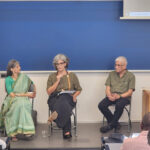By Joseph Purugganan
INTRODUCTION
Let me also begin by thanking Radhika Desai, and the International Manifesto Group for inviting me to be part of this panel tonight to help unpack China’s new trade deals.
I’ll be speaking about the RCEP as well but perhaps more from the perspective of a trade justice campaigner, questioning the rationale behind these ambitious economic agreements that have benefitted a few and for most part worked against the interest of the many.
There is now a strong push from governments across the 15 RCEP countries (ASEAN 10 plus China, Japan, South Korea, Australia and New Zealand) to galvanize broad public support for this comprehensive trade and investment agreement in a move to secure ratification and concurrence for it to come into effect. So far the deal has secured ratification in China and Thailand and the processes towards ratification have been initiated across all parties with most countries eyeing 2021 completion of this process.
But governments are leaving out crucial issues that must be considered, especially in light of the Covid-19 pandemic and the need to put in place more progressive economic policies that would support the needs of the poor and marginalized.
The Covid-19 pandemic, the contraction of the global economy, and growing calls from CSOs for a stop to FTA negotiations [1] were not enough to deter parties from the 15 countries negotiating the Regional Comprehensive Economic Partnership Agreement or RCEP to conclude the talks for what is now considered the world’s largest free trade agreement. We will recall that parties declared substantial conclusion of the talks as early as 2019 with only the trade in goods aspect left to be ironed out. And then the pandemic hit the globe in early 2020 and like everything else, RCEP talks were temporarily suspended.
Virtual negotiations restarted however in April 2020 and monthly online discussions ensued with two more negotiating rounds and two Ministerial conferences before the talks were concluded in November 2020. Thailand’s chief trade negotiator was quoted in the Bangkok Post as having said this about the negotiations proceeding despite the lockdowns: “We [trade negotiators] have completed many negotiation issues during the past two months. It is faster and saves on time and costs. Covid-19 brings a new normal to trade negotiations.”
The shift to online communications however had at least one casualty: civil society participation. In the first place, RCEP talks, and most FTA talks for that matter, have not necessarily been a completely open, transparent and participatory space for civil society engagement. In fact, in the case of RCEP, the only space for directly engaging the trade negotiating committee (TNC) called the Stakeholder Engagement Process, was only organized in 2016, a full 3 years since the negotiations had begun. The stakeholder engagement process nevertheless still provided a space, albeit limited, for CSOs and grassroots movements to raise concerns about the agreement directly to trade negotiators.
Selling the agreement as a big win for everybody
An agreement that has been kept off-limits to the public–with no access to the negotiation text and very limited engagements in the process– is now being aggressively sold by governments as part of the effort to secure parliamentary concurrence.
This drive to sell RCEP to the broader public and galvanize support for the agreement is evident in the pronouncements from governments on the significance of the agreement. A foremost concern, of course, across the globe is the pandemic and economic and social issues induced by the health crisis. It’s not surprising therefore that RCEP is being promoted as a key response to the crisis and a driver of recovery.
The Joint Leaders Statement on RCEP presented at the virtual signing ceremony in November 2020 asserted: “In light of the adverse impact of the pandemic on our economies, and our people’s livelihood and well-being, the signing of the RCEP Agreement demonstrates our strong commitment to supporting economic recovery, inclusive development, job creation and strengthening regional supply chains as well as our support for an open, inclusive, rules-based trade and investment arrangement.”
China’s Role in RCEP
One question that has continuously hounded these talks is what exactly is China’s role in these negotiations? Many have described the RCEP talks as China-led. If you take a broader geopolitical view and look at the landscape of FTA negotiations across the globe, it’s easy to see why one would think that way. Aside from RCEP, the global landscape is dotted with other key mega FTA negotiations. There was at one point the Transpacific Partnership Agreement or TPP, which many characterized as a US-led trade negotiations and the Transatlantic Trade and Investment Partnership agreement or TTIP between the US and the European Union, The EU itself was quite actively engaged in FTA talks with Asia, launching its New Partnerships with Asia in 2007 with simultaneous trade talks with India, South Korea and ASEAN.
Asia has become an important hub for these new generation FTAs. We can point to three main reasons why this is so. First, Asia is a high growth region, therefore its growing market is a target for economic expansion. Second, it is also an important source of raw materials. Developed economies need to import these raw materials in order to export competitively. Securing access to these raw materials is therefore an important strategic consideration; and the third reason is China. The EU and the US for instance connect China’s efforts to secure trade deals with the rest of Asia as expansion of its not just economic but political influence in the region.
On the other hand, if one looked at the agenda of pushing greater ambition and coverage, and of RCEP becoming a high standard FTA similar to the TPP, this agenda was pushed aggressively by Japan, Korea, to some extent Australia and lesser extent New Zealand, countries that are outside ASEAN that were also engaged in the TPP negotiations.
Then there is ASEAN and its projection of ASEAN Centrality or the assertion that RCEP is in fact built on ASEAN’s existing FTAs with its development partners. ASEAN developed its own guidelines for RCEP negotiations where it emphasised the importance of recognizing the asymmetries that exist among RCEP parties, and pushed for flexibilities for least developed countries. To what extent these flexibilities were reflected in the final text is therefore a true test of ASEAN centrality. And as I will point out later, while the RCEP did not turn out as the high standard FTA that some parties had hoped for, with some elements left out for the time being like the toxic investor state dispute settlement mechanism or the TRIPS+ provisions, it looks like despite provisions allowing flexibilities and sensitive lists, ASEAN will not benefit much from the deal and in fact would see its balance of trade worsen under RCEP.
Many have touted the agreement a “big political win for China,” highlighting how the agreement would sustain China’s “advantages in global supply chains.”
For his part, Chinese President Xi Jinping has made it a point to emphasize the global role of China. In a speech before APEC business leaders, Xi expressed confidence “that the steady unleashing of the China market potential will create vast business possibilities for other countries, and this will create stronger impetus for maintaining stable growth of the global economy.”
Other leaders have used RCEP as an opportunity to highlight RCEP in light of their own development needs. Sok Siphana, an advisor to the Cambodian government, referred to RCEP as a “victory of multilateralism and is a good pool for regional economic cooperation and integration.” The Vietnamese government on the other hand highlighted the potential opportunities for ASEAN and Viet Nam to “become a centre of investment attraction” but it also downplayed the risks saying the agreement “would not worsen the trade deficit Viet Nam was running with signatory markets.”
The Philippine government chose to highlight as well the positive impact of the agreement on investments. Lead Trade Negotiator Allan Gepty said ”the conclusion of RCEP will facilitate more investments into the region aside from allowing freer flow of goods among the 15 participating countries.”
Lost in the chorus of positive messages and effectively left out in the discourse however are key issues that have been consistently raised by CSOs and grassroots movements.
Secret Negotiations
The negotiations have clearly failed the transparency and public participation test. A CSO report on RCEP and Transparency found that there was no or little publicly available information on the state of negotiations, draft texts or key government positions throughout the negotiating process.[2] There were very limited or token/ad hoc stakeholder engagement forums. As mentioned earlier the first Stakeholder Engagement was tentatively conducted in 2016, 4 years after the negotiations were launched. Parliaments or other public institutions had very little opportunity to impact or influence the process while special interests and business groups have been given a privileged role and access to information.
Dangers of Modern FTA
Governments are bragging that RCEP is a modern FTA but give no further explanation of what that means or what the implications would be. A modern trade and investment agreement means that the scope and coverage of the agreement cover not just trade in goods, but also services, intellectual property rights, investments, and more recently includes a chapter as well on electronic commerce. A modern or new generation FTA would push further liberalization and deeper obligations to open up the economy and harmonization of regulations in the name of policy coherence.
While there are different templates, there are a number of key elements that are common in most modern trade and investment agreements. There is the push for stronger protection of intellectual property rights (IPR). IPR chapters of most of these agreements push for obligations that go beyond the minimum standard set out in the WTO Trade Related Aspects of Intellectual Property RightsAgreement. There is a huge disparity in the levels of IPR protection among the RCEP parties. Based on the World Economic Forum’s global competitiveness ranking on IPR protection we see Singapore (4th), New Zealand (6th), Japan (14th), and Australia (16th) rank highest in terms of IPR protection. While Thailand (121st), Cambodia (130th) and Myanmar (134th) are at the tail end of the global rankings.
A 2012 report by the UN Development Program and UNAIDS on the potential impact of free trade agreements on public health issued a strong warning to state leaders against trade agreements that inflate the price of medications and deny access to lifesaving treatments for poor citizens across the globe.[3]
There is also the agenda of investor protection, as exemplified in the ISDS provisions. For those who are not familiar, ISDS is the mechanism present in most modern FTAs that gives corporations the power to sue governments over public policies or regulations.
We can debate at length on which country drove the negations, whether it was China, Japan, Korea or ASEAN but one thing is clear, corporate agenda was definitely one of the key drivers.
Rising imports and declining exports
A new working paper from Boston University’s Global Development Policy Center focusing on RCEP: Goods Market Access Implications for ASEAN [4], by Rashmi Banga, Rashmi Banga, Kevin P. Gallagher and Prerna Sharma, a detailed disaggregated product-level impact analysis of tariff liberalization based on actual tariff schedules found out that:
1. The results of the simulations show that tariff liberalisation under RCEP will deteriorate the existing balance of trade of ASEAN vis-à-vis RCEP countries by 6 percent per annum, while balance of trade will improve for some of the non-ASEAN countries in the RCEP
2. The maximum gains in terms of improved balance of trade or net exports will go to Japan, followed by New Zealand and Australia. Post RCEP, balance of trade will worsen for Cambodia, Indonesia, Lao PDR, Malaysia, Myanmar, Philippines, Singapore, Thailand and Vietnam
3. RCEP sensitive list analysis reveals that it is the developed countries which have been able to negotiate higher protection against imports as compared to ASEAN countries or even least developed countries within ASEAN.
The balance of trade issue is also related to a question that governments prefer not to discuss, why India opted out of the agreement. India left the negotiating table in November 2019 because it felt that RCEP did not adequately address its concerns. A key concern for India is its ballooning trade deficit, particularly with China.
Impact on Covid response
Around 400 CSO from across the globe issued a statement in April 2020 calling on trade ministries and the World Trade Organization (WTO) to stop all trade and investment treaty negotiations during the Covid-19 outbreak. They called for “flexibilities to set aside trade rules that constrain the ability to resolve the pandemic crisis, without fear of repercussions, and to cease other negotiations and activities that divert their energy and resources from that goal.”
Trade and health advocacy groups have raised the concern that the agreement – the text of which was concluded in 2019, before the pandemic – could severely constrain policy space needed to effectively address the health and economic crisis. There have been no studies on the impact of these rules on limiting the ability of States to respond to Covid and future pandemics and emergencies, and ability to recover and rebuild economies.
This struggle against constraints to policy space from FTAs is evident in the current efforts to secure support for a TRIPS Waiver in the WTO. The proposal initiated by India and South Africa, which has now garnered considerable support from most developing countries to temporarily suspend trade obligations is being met by strong opposition from the US, the European Union among others and from Big Pharma.
In a recent hearing of the Senate Foreign Relations Committee in the Philippines on a proposal calling for the Philippine government to support the waiver, representatives from the Departments of trade, foreign affairs as well as the Intellectual Property Office (IPO) raised the concern that support for the waiver might ran contrary to obligations under FTAs signed by the Philippines namely with the European Free Trade Association and RCEP.
RCEP would also further lock- in countries to this FTA Regime that is already facing a lot of scrutiny not just from CSOs but also from institutions like UNCTAD. As Trade Justice Pilipinas articulated in its statement: “RCEP will further prop up a broken economic model that we need to radically transform in favor of one that is more resilient.”
What now for Trade Justice Movements?
A key battleground now in the campaign against unjust trade agreements is the ratification process for RCEP. Organizations and campaign networks across the region would have to argue in Parliaments and Congress against concurrence. This is a tough fight for CSOs considering the late and limited access to the official documents, and the strong support for the agreement from the business sector.
Another important task related to the concurrence process is analyzing the text of the actual agreement together with the schedule of commitments. CSOs would need to sharpen their arguments against RCEP especially as the agreement allows for future ratcheting of obligations in the key areas of investor protection, and intellectual property rights.
Finally, RCEP can be seen as opening the floodgates for more comprehensive and ambitious agreements. Already there are renewed calls for more trade negotiations with the United States under the new administration of President Joseph Biden, including the possibility of the US rejoining the defunct Comprehensive and Progressive TPP (CPTPP) and China joining the same, as well as new mega regional agreements under the mantle of Asia Pacific Economic Cooperation (APEC), and a host of bilateral FTAs.
Trade Justice movements across the region are now confronted with the major challenge of resisting this renewed push for FTAs like RCEP as key drivers of the recovery efforts, at the same time push the discourse towards more just economic policies that prioritize the needs of the poor and marginalized.
* The presentation is based on an article entitled What Governments are not saying about RCEP: Civil Society has a different take on what the trade deal means for participating countries originally published in German for the Newsletter Rundbrief (https://www.forumue.de/hintergrundanalyse/rundbriefe/) of the Forum Umwelt und Entwicklung (Forum on Environment and Development) based in Berlin.
[2]foei.org/…/secret-rcep-fails-transparency
[3] Purugganan, J. Asia and Mega FTAs. Focus on the Global South Occasional Paper. 2018.
[4]bu.edu/…/rcep-goods-market-access-implications-for-asean










